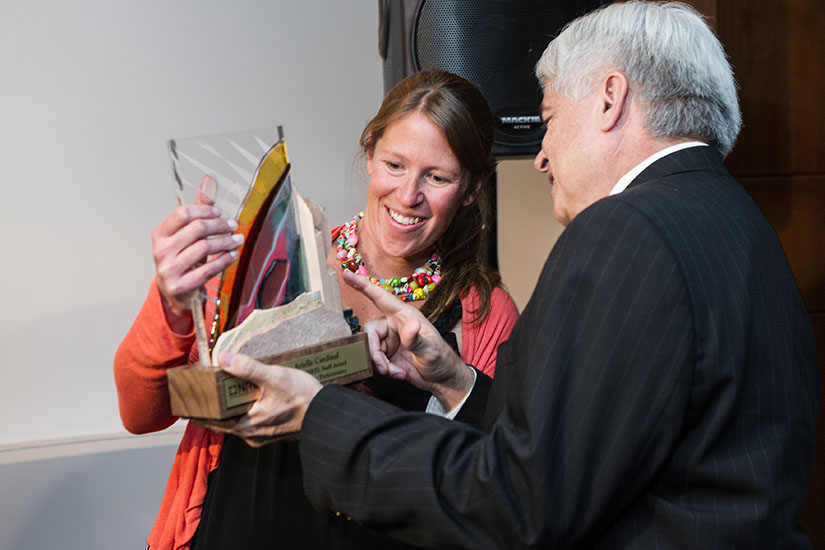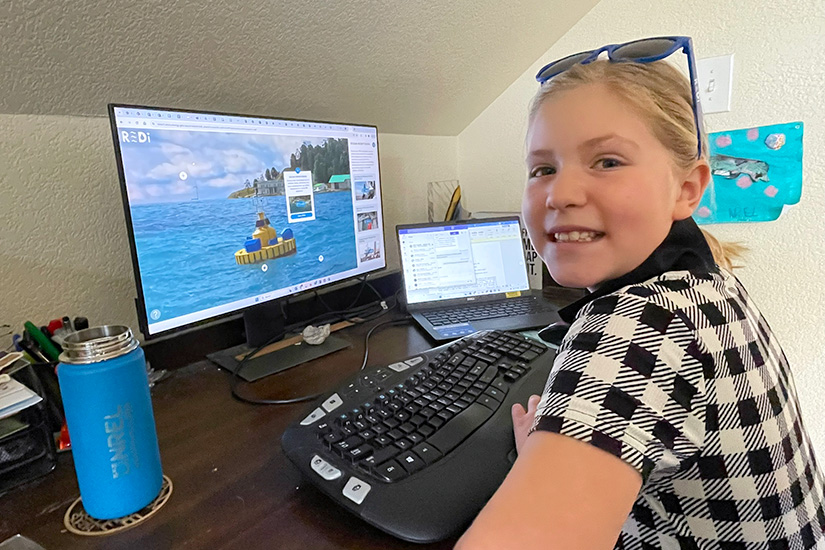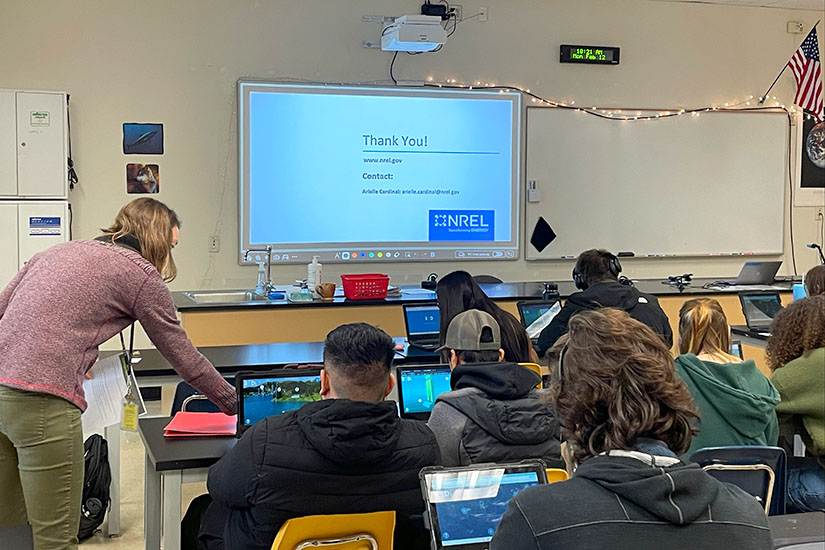Could a New Renewable Energy App Help Inspire Future Climate Crusaders?
Newly Launched Renewable Energy Discovery Island Could Make It Easy To Teach, Explore, and Learn About Clean Energy (Especially Water Power)
March 20, 2024 | By Caitlin McDermott-Murphy | Contact media relations
Eva Wolfe could not see the flames, but she knew they were out there.
It was early September 2020, a hot end to a hot summer, and Wolfe and her husband were living in Oregon's backwoods. The state was experiencing its worst drought in 10 years. Trees went thirsty and died. Scrub brush crinkled into kindling. And pandemic lockdowns drove Oregonions into one of their few escapes: the woods.
Then, on Labor Day, the woods ignited. Blustery winds fueled five megafires and 12 others, which consumed a million acres in just a few days.
Out in the woods, Wolfe knew one of those fires was burning just over the nearby mountain ridge. She stayed up all night, hitting refresh on the one Facebook page that shared updates on the fire's progress. In the morning, the sun rose red, illuminating a Mars-colored world. Wolfe kept hitting refresh as she prepped her first lessons. School was starting soon. And Wolfe, who teaches high school environmental science, knew her students would have questions about what was happening to their home. She was right: "All the kids were like, 'Why is our state on fire?'"
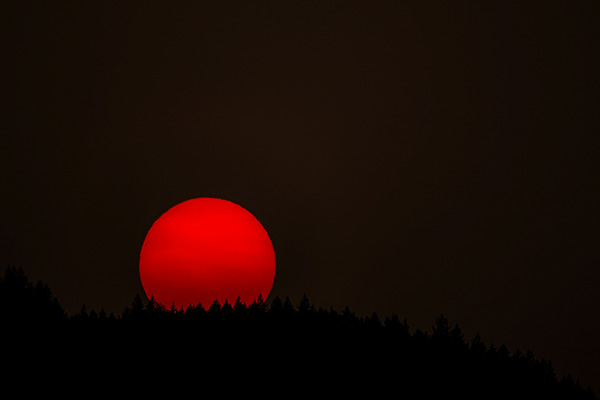
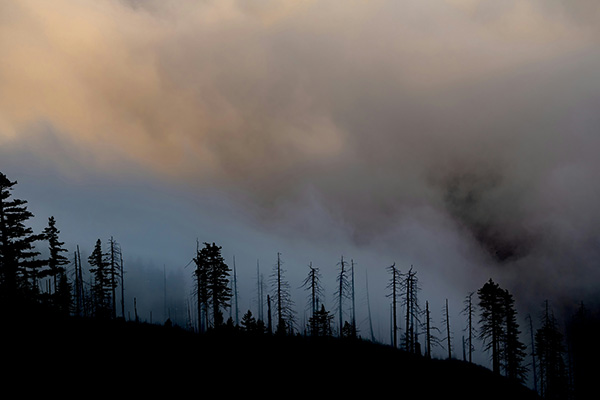
In 2020, Oregonians lived through the most destructive wildfire season in the state's history, which came with eerie red sunrises and huge swaths of burnt forest. Photos from Chris Leboutillier, Unsplash
Seeing Is Believing … in a Better Future
Climate change wreaks all kinds of insidious havoc.
Some impacts, like wildfires, are easy to see; others, like economic strain, asthma, or infectious disease, are less visible. Such an amorphous, multiheaded threat can be challenging to teach, if it is taught at all. Most teenagers get their climate change information (or disinformation) on social media. Each state gets to decide how much of their public school curriculum will be dedicated to climate change (and the amount varies widely). Plus, not only is the topic complex—spanning a vast world of causes and solutions, many of which cannot be fully understood without some basic science—but it can also be anxiety-provoking. More than half of young people today feel “very or extremely worried” about climate change. Gerunds and geometry do not cause the same existential angst.
When wildfires—or floods, superstorms, or pandemics—threaten your home, it is hard not to feel hopeless. Wolfe has often heard her students say: “Oh well. We’ll just move to Mars.”
And yet, recent studies suggest that focusing on solutions, action, and a sense of agency can help young people overcome climate anxiety. One of the most promising solutions is clean energy: If the world can switch from fossil fuels to clean energy sources, like solar, wind, geothermal, water, and more, we could dramatically reduce our greenhouse gas emissions. Now, the U.S. Department of Energy’s National Renewable Energy Laboratory (NREL) and Water Power Technologies Office (WPTO) have created a tool to help students visualize these technological solutions.
Enter: Renewable Energy Discovery (REDi) Island.
On Feb. 1, 2024, NREL, WPTO, and IKM 3D released the long-anticipated REDi Island app, an educational virtual world powered entirely by renewable energy.
REDi Island is designed for students from high school and beyond (and eventually from kindergarten on up), educators (like Wolfe), or anyone curious about how we can build a more sustainable world powered by clean energy. Students can explore technologies and careers through waystations, videos, 3D visualizations, and more. And teachers can access curriculum resources and activities, like a scavenger hunt that encourages users to think like a fish.
Right now, REDi Island gets most of its energy from water power because, well, it is an island. These coastal communities live right beside powerful ocean waves, currents, and tides, and an energetic river, too. In the future, the app developers plan to add even more renewable energy for users to explore (although users can already find two nonwater-power technologies churning out clean energy).
For now, this water-powered world can teach all about how steady hydropower and up-and-coming marine energy could help the country build a 100% clean energy power system. REDi Island can also help students envision how they, too, can power this sustainable world by joining a vast range of water power careers.
"It's very cutting edge," said Wolfe, who helped beta-test the app and plans to use it in her classroom. "I like that it lets kids imagine how we could power our entire society with renewable energy because everyone's always telling us that's impossible."
Seeing is believing, as the adage says. But it is also what the research says about climate communication: Visuals and videos are not only better at conveying abstract, esoteric concepts; they are also more likely to spark an emotional response. And emotions push people to act.
In REDi Island, users can see how river currents power a farm, how waves help generate clean drinking water, how bobbing buoys warn ships to avoid a coral reef, and how hydropower keeps a city's lights on. They can watch educational videos on, say, "the wonder of wave gliders," spin a 3D replica to examine what a winch drum does, or slip under water to discover if any featured technology is shorter than LeBron James.
As of the launch date, users can fully explore four of REDi Island's 15 waystations; two others are visible but not yet complete, and the final nine will open in the coming months. Each station includes visual representations of a specific kind of renewable energy technology, like the observation buoy and surge flap pictured here, as well as videos, 3D replicas, and other educational resources.
"It's really challenging to get excited about science if it's stuff that they can't relate to in their real lives," Wolfe said. "The more that you can get kids playing around with things and seeing how things work, the better."
Or, as one 9-year-old student student put it: "It's better than regular classroom lessons because it's 3D." Lucy Cardinal got a chance to play with the web-based app before it launched. "And your teachers are not just talking to you (no offense to Mrs. Ward)," Lucy said. Mrs. Ward is her (beloved) teacher.
Why the World Needs Water Power, and Water Power Needs REDi Island
About three years ago, a group of NREL researchers realized water power had a problem. Unlike other renewable energy technologies, like rooftop solar panels or wind farms dotting plains next to highways, water power technologies are often overlooked.
Hydropower, one of the oldest renewables, has an invisibility problem: Often, hydropower facilities blend into the landscape and go unnoticed and underappreciated. Yet they provide a solid foundation for the country to transition to clean energy.
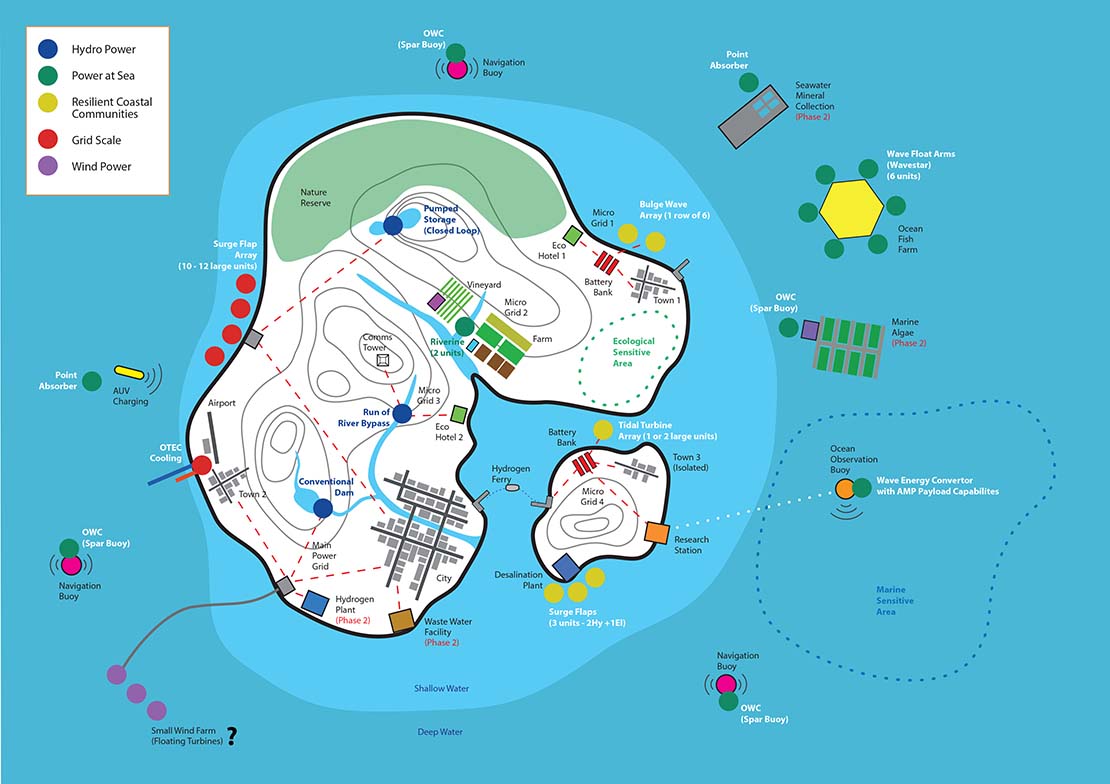
Not much has changed—at least in the overall island layout—since the REDi Island team drew this early schematic. The team started working on the app about three years ago after they realized that water power, including hydropower and marine energy, are often left out of discussions about renewable energy.
And if hydropower is hard to find, marine energy technologies are even harder: Although this industry is getting closer to commercialization, many devices are still prototypes, being refined in labs or under water. The United States has enough marine energy resources—which include energy generated from fast-flowing rivers and ocean waves, currents, tides, and even shifts in salt levels or pressure—to meet nearly 60% of the country's electricity needs. We cannot harness all that power, but the grid will need all the clean energy it can get. And these budding technologies could be especially valuable for offshore workers, like marine researchers or seafood farmers, as well as coastal and island communities (like, say, the invisible residents of REDi Island).
The problem is, these industries need a robust workforce to design, build, refine, modernize, test, maintain, operate, and study these technologies, so they fulfill their climate-change-fighting potential.
So, how do you encourage people to care about something they cannot even see?
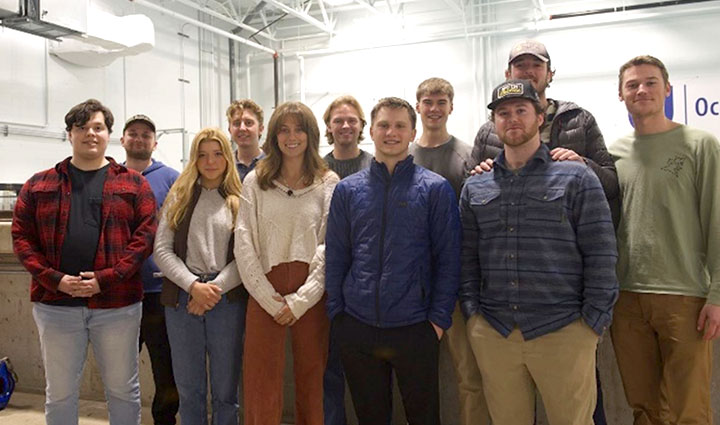
Will Moore (front, fourth from the left) and this team of University of New Hampshire undergraduate students recently competed in the Marine Energy Collegiate Competition. Moore hopes that one day, REDi Island will include the device his team worked to build—an open-ocean buoy that tracks weather and ocean-current data using the power of the ocean. Photo from the University of New Hampshire
In REDi Island, students not only get a chance to explore these often-invisible technologies, but they can also explore water power career options. Not all water power workers need a degree in engineering or a passion for tinkering with gears, motors, or electrical wires. Future water power workers could also help grow new coral reefs, draft ocean policy, weld metals together to fix underwater technologies, monitor fisheries or tsunamis, capture carbon, or even help communities get clean drinking water or recover from natural disasters. (Folks can find even more water power careers—and guidance on how to join them—with the U.S. Department of Energy's water power career maps).
"Plenty of young people care about renewable energy. They just might not know how to engage in the topic or become aware of how they can participate," said Will Moore, an undergraduate student at the University of New Hampshire.
Moore, who is studying mechanical engineering, knew nothing about marine energy until he and a team of his fellow engineers participated in WPTO's Marine Energy Collegiate Competition. "It opened my eyes," he said. "I'm only an hour and a half from the ocean at the most. But I've never really heard of marine energy."
Moore said he appreciates that users can choose how much information to glean from REDi Island's knowledge nuggets. Some technical bits, like how multimedia filters remove large particles or oscillating water columns generate energy, are better suited for more advanced students while animated videos about Hawaii's humpback whales or a glowing fish sculpture named "Gil" might entice younger learners.
"When you say this device's power is 15 kilowatts, younger kids might not know what that means," Moore said. "But if you said you could power your house for two days, they can get a better understanding. People are always surprised how much energy can actually be harvested."
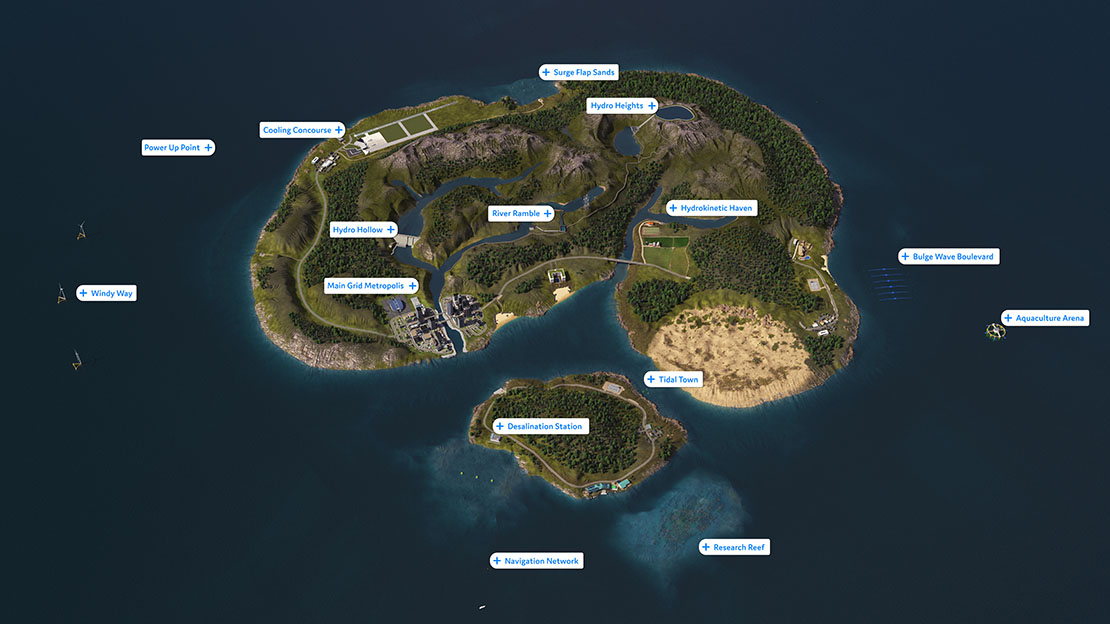
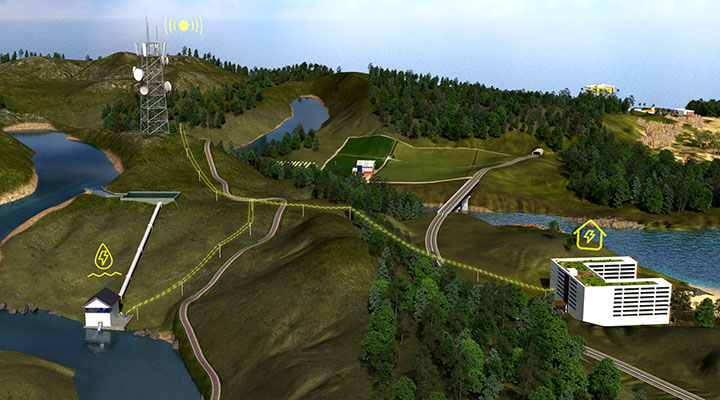
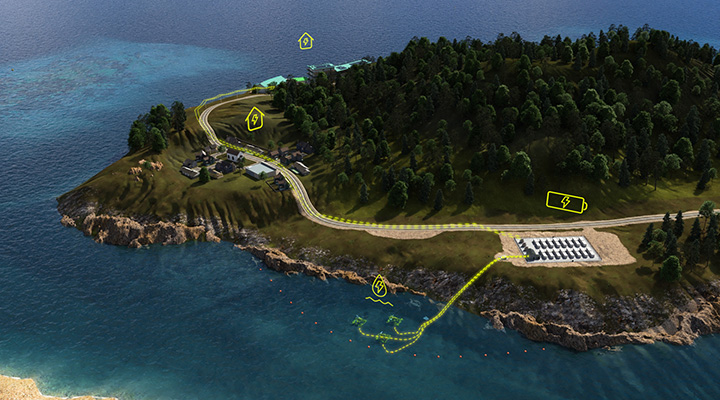
REDi Island provides teachers and students with a way to explore solutions in a world that is successfully fighting the climate crisis. That is critical to help combat climate anxiety, which can prevent people, especially today's younger generations, from feeling empowered enough to take action.
"It's So Much More Than a Mario Brothers"
A clean energy future sounds lovely. And yet, much of today's news about climate change can still feel dire and depressing. It is easy for people to simply shut the news off and shut down. But apathy is the opposite of what the world needs. The planet needs action.
In the United Nations tips for talking about climate change, they state: "A good way around disillusionment and 'crisis fatigue' is to convey a hopeful message focused on the solutions, helping people feel empowered and motivated to engage."
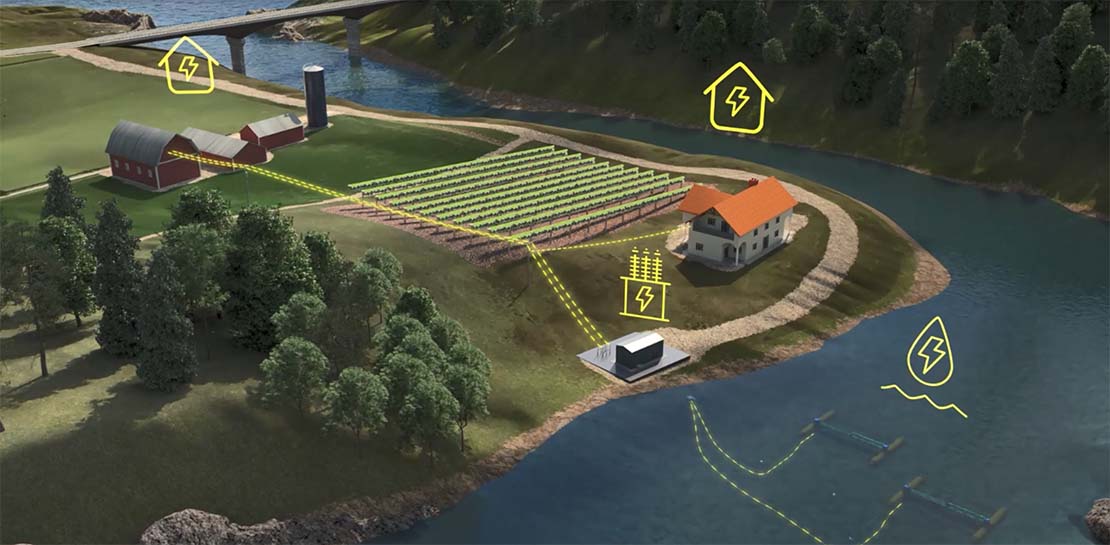
In River Ramble, one of REDi Island's forthcoming waystations, a farm runs exclusively on energy generated from river currents. This might seem too good to be true, but a rural town in Alaska, called Igiugig, is already generating energy from its powerful Kvichak River.
In REDi Island, people can escape into a future where those solutions are already creating the world we need. That world might seem as magical as living on Mars, but unlike that fantasy, REDi Island's dream is closer to becoming a reality. The country is ready to build communities that look like REDi Island; these climate-fighting industries just need people to care and get to work.
"The kids, they're ready for the real-world things they hear about routinely, right?" Wolfe said. "For them, it's about the cause."
Future generations can get excited about tidal turbines, run-of-river hydropower, or protecting coral reefs without carrying the weight of saving the world. Although users can explore just four of 15 renewable energy waystations currently, the next 11 are expected to open in the coming months; those who are too excited to wait can watch videos on all 15 waystations, including Cooling Concourse, Aquaculture Arena, and Hydro Heights, on YouTube.
"It's so much more than a Mario Brothers," 9-year-old Lucy said. "It's actually giving you facts so you can learn, and it's really fun. My friends are going to love this."
If enough people pick up REDi Island, maybe Wolfe's students will no longer see Mars as their only hope. Maybe someday, she'll hear them say: "Oh well. We'll just move to REDi Island."
Learn more about science, technology, engineering, and mathematics (STEM) careers and workforce development opportunities on the Hydropower STEM Portal and Marine Energy STEM Portal .
Subscribe to NREL's newest water power STEM newsletter, the SPLASH (Student-Professional Learning and Sharing Hub), to stay up to date on exciting research.
Share
Last Updated Aug. 29, 2025

